Ultius Blog
The 2015 Indonesian Wildfires – Everything You Need to Know
George Monbiot, a writer for The Guardian, has regarded the latest in the world’s environmental disasters best by reminding us where our priorities lay as humans. He speaks of the world focusing on the trivialities of culture such as fashion, political shenanigans, and entertainment intricacies while an entire population of people are dealing with a nightmare come true. He states in his article, Indonesia is burning. So why is the world looking away, that:
“in Indonesia, fires are raging. They are…producing more carbon dioxide than the US economy. And in three weeks the fires have released more CO2 than the annual emissions of Germany.”
That was just in the year 2015.
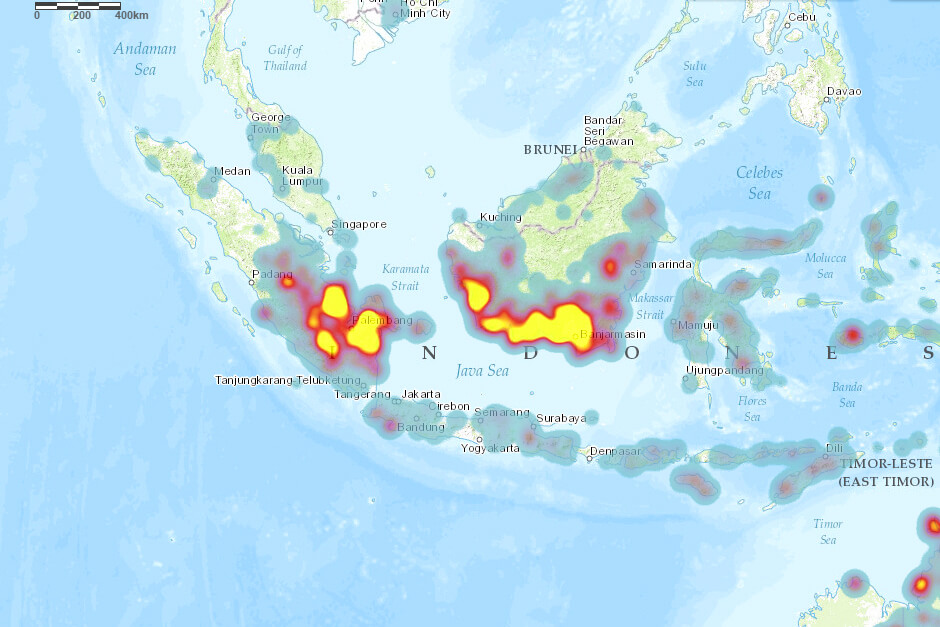
Today, the fires continue to burn. The culprit: mankind. According to Manbiot, the forests in Indonesia have been pilfered for its timber for decades. The land is being “slashed and burned” to make way for new resources, such as palm oil. Cheap and easy replacements must be planted, grown, and cultivated. The effects have been devastating, and recently, it has become an issue so great that all walks of life in the area are being affected, including:
- Human health
- Wildlife
- Politics
- Environment
- Agriculture
- Economics
The purpose of this discussion is to shed light on the Indonesian fire disaster and how it is affecting the world.
How did the fires in Indonesia start?
These recurring wildfires are the result of an overall annual purging that has occurred for many years in the Southeast Asian region, specifically around the country of Indonesia. The most recent, and most devastating outbreak started sometime in July of 2015, when companies started clearing tracts of land in Indonesia for timber. Their intent was to strip the land of forests to replace it with crops, particularly palm oil.
Years of carelessness and unregulated clearing of land, have resulted in recurring blazes that are never fully extinguished.
A problem of peat
Indonesia sits on expansive plots of peat soil, which is highly flammable when it is dried out. Once the forests have been burnt away, the peat covering the bottom of the forest floor is keeping the fires alive. Here in the United States, the wildfires that occur almost annually in places like California, are usually the result of a lack of rain combined with dry trees and shrubs. When these fires are extinguished, they normally don’t start up again until the next dry season.
In Indonesia, the peat covering the forest floor is continuously smoldering. This continued smoldering means that the fire is never completely extinguished, and can flare back up, at any time.
According to the International Peat Society, peat is a type of soil comprised of decomposed vegetation common in wetland environments where oxygen saturation is extremely low. When land cultivators arrive, and begin clearing land in a process known as “slash and burn”, the peat is dried out. It does not take much for the peat to ignite in dry seasons, causing forest fires to break out.
Once the precious trees are burnt to the ground, the land begins to smolder and burn as well. These smoldering beds of peat are the primary source of what is causing so much damage throughout Indonesia some neighboring countries.
Size, damage, and regions being affected by the fire
The World Bank has estimated that at least 2.6 million hectares of land and trees burned in 2015 alone. TIME magazine has reported that there were around 100,000 fires burning at one time. While those statistics reveal the size of the area that the fires have impacted directly, it is merely the amount of land that has burned.
It does not account for the total area affected by the disaster in other ways. It also does not take into account the possibility for more fires in the future. The reality of the situation is that these fires are not a new occurrence, but an event that is gradually worsening each year, with 2015 being the worst year on record yet.
Not just an Indonesian disaster
In terms of regions being impacted by the fires, Indonesia and its nearest lying countries, including Malaysia, Thailand, the Philippines, and Vietnam are all feeling the brunt of the effects. Borneo Island and western Sumatra are among the worst hit areas. Malcolm Farr and Charis Chang from news.com.au report that the noxious haze is reaching as far as Australia. El Niño and shifting weather patterns are only exacerbating the conditions and causing the pollution from the fires to spread further over most of Southeast Asia.
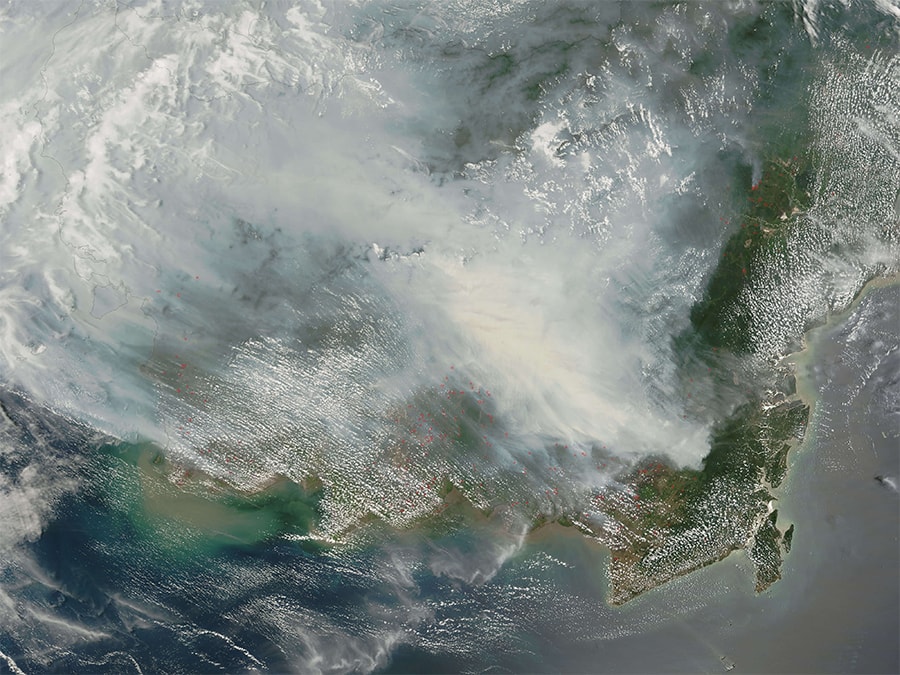
Why is the fire so difficult to stop?
Many people are wondering why these fires are so persistent and unlike other forest fires that the world has contended with. As mentioned earlier, the critical issue resides in the peat soil that, when dried out by the fires from the forests, burn relentlessly at above, below, and at ground-level.
These smoldering, not flaming, fires burn significantly longer than fires fueled by other types of combustibles. Wildfire Magazine reports that the most studied “megafire”, as related to peat-based events, was in fact, also located in Indonesia in 1997. Due to the porous, dense nature of peat, combined with super-thick material in some areas, it is not uncommon for these types of fires to burn for months or even years even with substantial rainfall and fire fighting measures.
Other incidences of large, hard-to-control fires related to peat include:
- Borneo, Indonesia: 1997
- Okavango, Botswana: 2000
- Evans Road, North Carolina, United States: 2008
Palm oil
A product that keeps coming up in the discussion regarding the Indonesian fire disaster is palm oil, which is harvested from the fruit of the oil palm tree. It is important to understand the role that palm oil plays in these fires, because the its production is essentially the cause of these consistent fires.
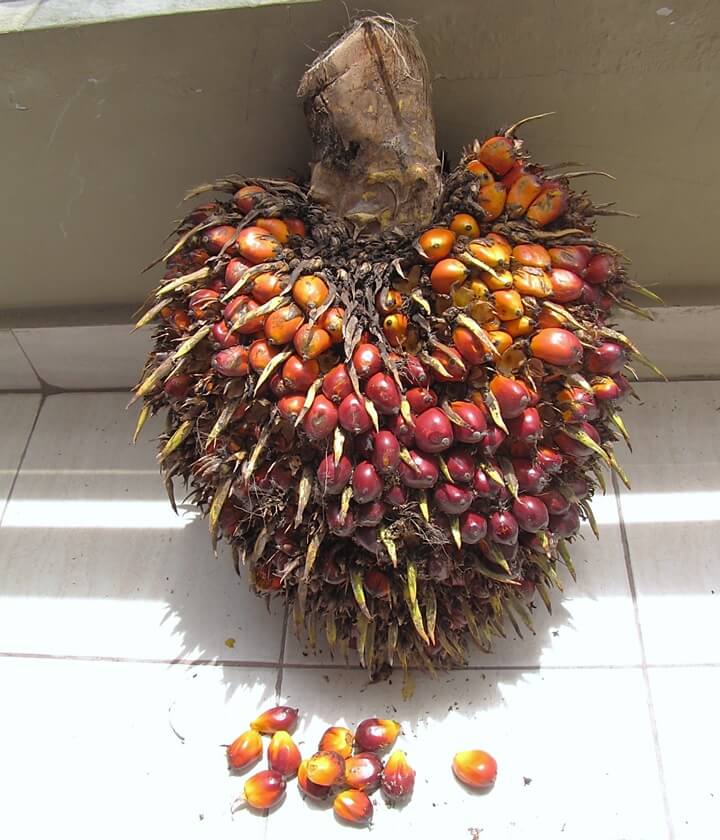
Palm oil production has not always been the monumental issue that it is today. The World Wildlife Fund (WWF) reports that in the mid-1980s, Indonesia only had a few thousand miles of plantations devoted to growing palm oil. By 2005 that numbered had multiplied ten-fold. It is now estimated that number will continue to spike to metric proportions by 2020, quadrupling what is there now.
There is much the average person doesn’t know about palm oil. While many speak out in regards to the dangers of palm oil production, there are benefits to the crop as well. If you wanted to fully understand the Indonesian fire disaster, you would need to know more about the production of palm oil.
Despite the pros and cons linked with palm oil, it is showing no signs of dissolving anytime in the near or distant future, since some of the most popular items in the average, American home contain palm oil. Palm oil can also be converted to a type of biodiesel fuel, as mentioned in a previous blog post from Ultius.
Items containing palm oil, according to the World Wildlife Fund include:
- Lipstick
- Ice cream
- Detergent
- Shampoo
- Cookies
- Margarine
- Packaged bread
| Fact | Pro | Con |
| It comes from palm fruit. | It is a high-yielding crop. | It is linked with the endangerment of Sumatran tigers, orangutans, and other wildlife species. |
| It is a type of vegetable oil. | It is trans-fat-free. | It is responsible for thousands of human and land rights conflicts. |
| It is in about 40-50% of household products including food, cleaning supplies, and beauty products. | It is cheap to produce. | It is not easily sustainable. |
| 85% of it comes from Indonesia and Malaysia. | It is quickly produced, harvested, and manufactured. | Its production is resulting in the destruction of rainforests in Southeast Asia. |
| It accounts for at least a third of the world’s vegetable oil source. | It helps with economic development of impoverished countries. | It is contributing to global climate change. |
| Table sources: http://www.saynotopalmoil.com/Whats_the_issue.php http://www.onegreenplanet.org/animalsandnature/top-10-facts-you-need-to-know-about-palm-oil/ http://www.institutmolinari.org/IMG/pdf/note0912_en.pdf |
||
The environment and carbon
These fires are destroying everything around them. One of the primary concerns of this disaster is the amount of pollution these fires produce. The amount of pollution in the air is measured on an air quality index. Information on The World Air Quality Index Project’s website reveals the following information.
Measured under 50, air quality is good; anything over that and people often start to feel the effects. As of the date of this writing, the air quality index for Jakarta, Indonesia was around 99 in the morning hours. This hovers around the 101-150 bracket which is an “unhealthy level for sensitive groups.”
Alarmingly, this number is occurring in the off season of the annual burning. It is nearly unimaginable what the air quality is like in the height of the “slash and burn” season. So far, it has proven to be bad enough for schools to close, airports to cancel flights, and sporting events to be postponed, reported Huileng Tan via CNBC, in August of this year.
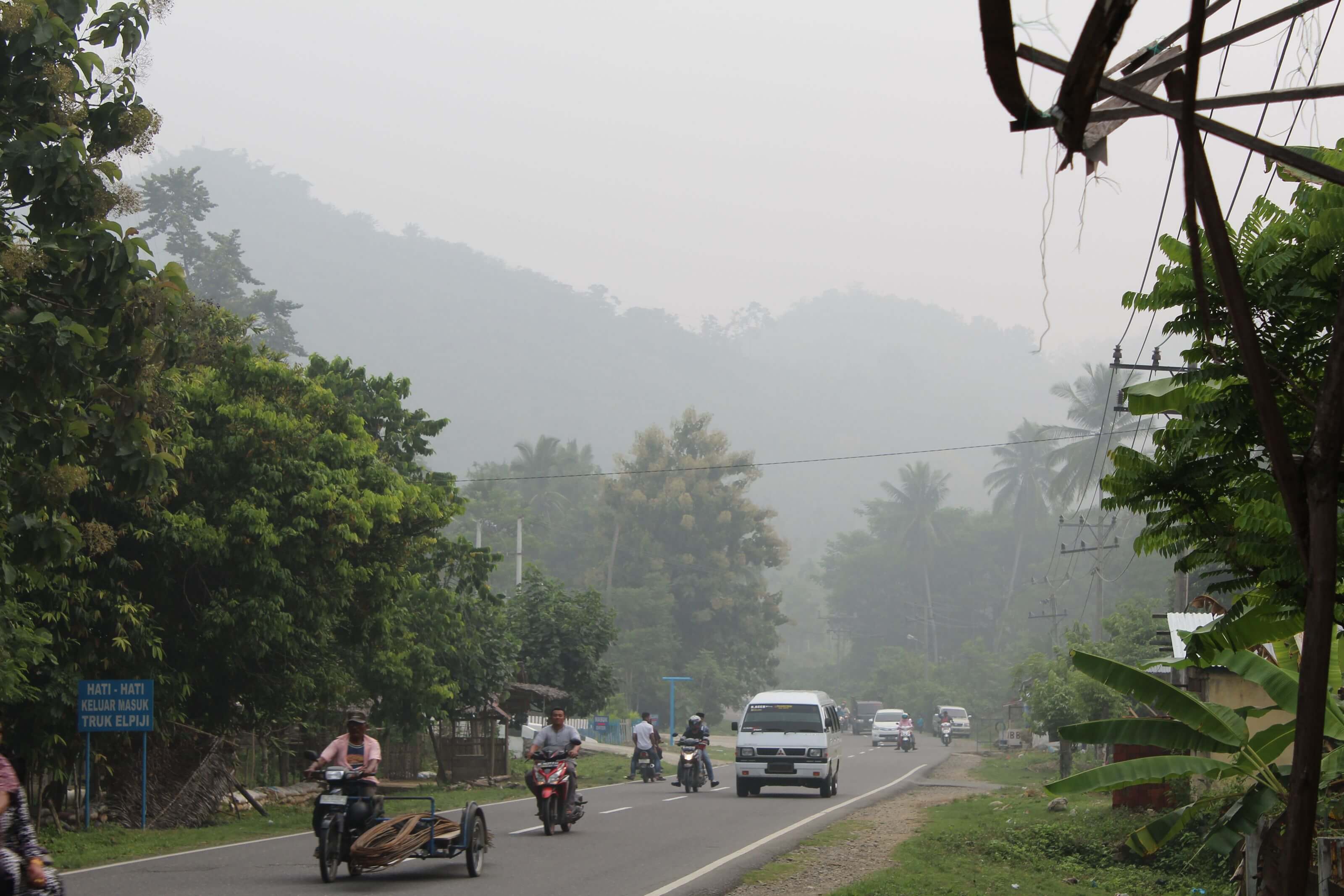
Larger carbon picture
In regards to what is being unleashed into the environment, carbon is the main cause of concern. As noted before, the outbreak in 2015 produced more emissions than the entire United States Economy (Harris, Minnemeyer, Stolle, & Payne, 2015). All this gas is originating in the peat that is being burned almost daily.
Carbon-rich and fermenting for thousands of years, areas such as Indonesia sport some of the most significant amounts of carbon on the entire planet. Even worse than the carbon being emitted into the air, deadly methane gas is also being released in record breaking amounts. So now, it is not just Indonesia dealing with this crisis, but the entire world, as this disaster only contributes to further climate change.
International response and assistance
The international response to the activity in Indonesia has been great. While many nations have only expressed outrage, and done little to help remedy the situation, there has been some positive actions being taken from other countries. The United States offered several million dollars to help, along with necessary fire-fighting equipment, masks to minimize the effects the smog is having on the people, as well as special facilities for the sick (USAID Press Office, 2015).
Humans, fauna, and flora threatened by the fire
It is more than just the environment being threatened by the Indonesian fire disaster. Humans, wildlife, and the plant population in the countries being affected by the fires are paying a hefty price as well.
| Humans |
|
| Wildlife |
|
| Plant life |
|
| Table sources: http://citeseerx.ist.psu.edu/viewdoc/download?doi=10.1.1.709.6831&rep=rep1&type=pdf https://www.sciencedaily.com/releases/2016/09/160919162849.htm http://www.worldbank.org/en/news/feature/2015/12/01/indonesias-fire-and-haze-crisis http://www.nytimes.com/2015/10/31/world/asia/indonesia-forest-fires-wildlife.html?_r=0 |
Who is protecting those affected?
Now that we have a concrete understanding of how serious this disaster is, and the impact it’s having, a closer look at who is helping those affected by the fires would be appropriate. The good news is that there is help. One such organization that is usually in the thick of it all when it comes to almost anything Mother Nature related is the infamous Greenpeace International.
Adi Prabowo of Greenpeace, reports on the organization’s website that one of their most recent endeavors involved blocking the delivery of a large shipment of palm oil into one of Europe’s largest palm oil refineries, IOI, in the Netherlands. He also makes note that all the volunteers dedicating their time and resources to the Indonesian fire disaster are highly educated on forest fires, from prevention to actually fighting them.
Other efforts in protection and detection
Another environmental group that is reaching out a helping hand to this effort is the World Resources Institute (WRI). WRI’s main contribution to this issue is providing as much information to the public as possible by using satellites and computers linked to their forest-fire tracking website. The website also hosts a blog, self-analysis tool, and sign-up option for individuals to receive fire alerts. For example, the site reveals that there were almost four hundred fire alerts in the areas most affected by the disaster in a one week period in March of this year alone.
RSPO (Roundtable on Sustainable Palm Oil)
There is one group who is making every attempt possible to help palm oil become more environmentally friendly. The main aim of this group is to find a solution to creating a more sustainable resource in regards to palm oil, so that all of the issues surrounding the destruction in the Asian region can be halted.
This group is called the Roundtable for Sustainable Palm Oil, or RSPO. The vision, mission, and purpose of the RSPO is relatively cut and dry. They are in the business of producing palm oil and keeping it available to the global public, but not with the catastrophic effects that other, less environmentally conscientious producers are.
Membership to the organization is an easy process, and their website hosts a variety of informative and action-oriented options to help the situation occurring in Indonesia.
Corporate response to palm oil production
In terms of the corporations who rely heavily on the palm oil that is being exported from the region, there are many who are taking a stand against what is happening by taking pledges against the deforestation that is occurring. Brittany Patterson of Scientific American mentions companies who have taken such pledges.
Companies pledged to reduce the harm being done by palm oil production
- Dunkin’ Brands Group Inc.
- ConAgra Foods Inc.
- Kellogg Co.
- Cargill Inc.
- Procter & Gamble Co.
- Mars Inc.
These pledges are creating a more prevalent awareness within the corporate community, but it is not eliminating the problem altogether. It appears that more influence needs to be placed on sustainable resources instead of loosely binding pledges. The following table shows some of the world’s major corporations and the commitments they have made to help alleviate their roles in creating healthier means of harvesting palm oil.
| Cargill Inc. | ||
| Participates in sustainable resource solutions | Endorses New York declaration on forests | Member of Roundtable on Sustainable Palm Oil (RSPO) |
| Yes | Yes | Yes |
| Kellogg Co. | ||
| Participates in sustainable resource solutions | Endorses New York declaration on forests | Member of Roundtable on Sustainable Palm Oil (RSPO) |
| Yes | Yes | Yes |
| Mars Inc. | ||
| Participates in sustainable resource solutions | Endorses New York declaration on forests | Member of Roundtable on Sustainable Palm Oil (RSPO) |
| Yes | No | Yes |
| Johnson & Johnson Co. | ||
| Participates in sustainable resource solutions | Endorses New York declaration on forests | Member of Roundtable on Sustainable Palm Oil (RSPO) |
| Yes | Yes | Yes |
| Unilever | ||
| Participates in sustainable resource solutions | Endorses New York declaration on forests | Member of Roundtable on Sustainable Palm Oil (RSPO) |
| Yes | Yes | Yes |
| Procter & Gamble Co. | ||
| Participates in sustainable resource solutions | Endorses New York declaration on forests | Member of Roundtable on Sustainable Palm Oil (RSPO) |
| No | Yes | No |
| Dunkin' Brands Group Inc. | ||
| Participates in sustainable resource solutions | Endorses New York declaration on forests | Member of Roundtable on Sustainable Palm Oil (RSPO) |
| No | No | No |
| Delhaize | ||
| Participates in sustainable resource solutions | Endorses New York declaration on forests | Member of Roundtable on Sustainable Palm Oil (RSPO) |
| Yes | No | Yes |
| Hershey's | ||
| Participates in sustainable resource solutions | Endorses New York declaration on forests | Member of Roundtable on Sustainable Palm Oil (RSPO) |
| Yes | No | Yes |
| PepsiCo | ||
| Participates in sustainable resource solutions | Endorses New York declaration on forests | Member of Roundtable on Sustainable Palm Oil (RSPO) |
| Yes | No | Yes |
| Table sources: https://www.scientificamerican.com/article/hellish-fires-in-indonesia-spread-health-climate-problems/ https://ults.co/2jwlLZx https://sustainablebrands.com/read/leadership/indonesian-forest-fires-amazon-tipping-points-and-the-business-case-for-investing-in-reforestation https://www.rspo.org/about |
||
Official government response from Indonesia
It is completely reasonable to assume with the number of people being affected by the fires, the economic toll being taken on the country, and the international backlash being handed out, the Indonesian government would have figured out a way to remedy the situation. Sadly, that is not the case. It appears that there are too many hands in the pot for Indonesia to enact environmental policies similarly to the way the United States has.
Corruption within the government, forestry industry, and big-brother corporations are thwarting the efforts of current Indonesian president, Joko Widodo, to stop the fires from destroying his country. Since the fires have been an issue that have become increasingly worse over the past few decades, it is not fair to point fingers at him alone. One of the worst outbreaks occurred in 1997 while former president, Suharto, was in office.
Since 1997, last year (2015) was the worst recorded year for the fires. That makes it Widodo’s problem now. In an interview with BBC, he talked about the measures he was taking to combat the flames.
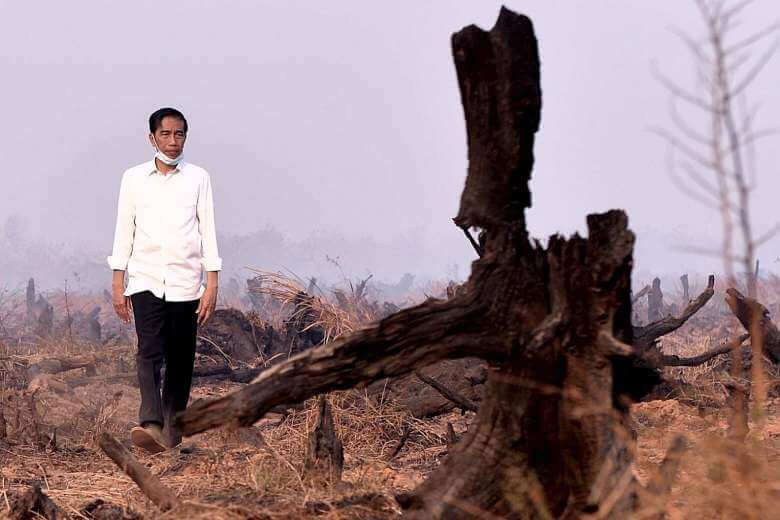
Measures being taken to combat the fires include:
- The deployment of several thousand police and soldiers to combat the fires
- Utilizing water-bombing planes to help extinguish the fires
- Suggestions made to prohibit any further cultivation of the peatlands
- Sending out environmental workers to aid in rehabilitation efforts
- Criminally prosecuting companies involved in intentionally setting fires
- Instituting future legislation and rules against any activity detrimental to the cause of putting out the fires permanently
Related cases
The fires that flared up in Indonesia in 2015 were some of the worst on record. The sheer number of people whose health has been affected as a result of the toxic pollution that the fires have released is immeasurable at this point. This recent incident is not the only one that has gripped the region in the last few years though.
As mentioned before, the 1997 fires and the El Niño that occurred that year grabbed the attention of the world, much like 2015. A report issued by the Overseas Development Institute reveals a similar scenario to the Indonesian fire disaster of 2015. The intentional setting of fires to burn cleared tracts of land, combined with an unusually dry season and El Niño, cloaked the region in smoke and destroyed almost everything within its grasp.
Indonesia is not the only country that has been plagued with disasters for the sake of business. It appears wherever there is a dollar to be made in regards to the Earth’s resources, tragedy is bound to strike. The following table represents some of the worst disasters in history involving natural resource collection and business.
| Centralia mine fire (1962)1 | Coal mining industry | ||
| Details | Recurring Event | |
| A fire was set to clean up the town’s landfill and spread into abandoned coal mines underneath. The fire eventually spread underneath most of the town and carbon monoxide gas seeped into homes. The town was evacuated. | Yes | |
| Exxon Valdez oil spill (1989)2 | Crude oil drilling | ||
| Details | Recurring Event | |
| Supertanker Exxon Valdez malfunctioned resulting in the dumping of over 10 million gallons of oil in Alaska. Wildlife, sea life, and plant life were affected immeasurably in the largest oil spill in American history. | No | |
| Church Rock uranium mill spill (1979)3 | Radioactive materials mining | ||
| Details | Recurring Event | |
| A dam holding back millions of gallons of radioactive mining waste burst and destroyed the Rio Puerco River, a vital water source. Humans, wildlife, local livestock, and neighboring farms were affected by the accident. | Yes | |
| The Dust Bowl (1934 - 1937)4 | Farming | ||
| Details | Recurring Event | |
| Over-farming combined with a severe drought caused a violent and destructive dust storm affecting over 150,000 square miles from Texas to Oklahoma. Nearly 60% of the population had to flee the region. | Yes | |
| Poison in Minamata Bay (1932 - 1968)5 | Industrial manufacturing | ||
| Details | Recurring Event | |
| For decades, the Chisso Corporation dumped industrial waste into the Minamata Bay. The waste consisted of extremely high levels of mercury. The disaster resulted in “Minamata Disease”. | Yes | |
| Table sources: 1. https://www.centraliapa.org/about-centralia-pa-mine-fire/ 2. http://www.hanksville.org/voyage/misc/uranium/ChurchRock.html 3. https://www.history.com/topics/great-depression/dust-bowl 4. http://www.kwanga.net/apesnotes/minamata-disaster.pdf/ |
||
What is the current status of the fire?
Though the fires have calmed since last year, it appears that the haze is primed to return. We already know that the fires have been an annual occurrence for decades, so this year, and the years to follow, are likely only going to produce more fires. There are conflicting opinions on what the current status of the situation is.
In August of this year, Adam Harvey of ABC reported on testimonies that revealed information about the fires on opposite ends of the spectrum. This information ranged from the fires were flaring back up to monstrous proportions according to the media, to Indonesia’s Disaster Management Agency claiming confidence in the fires not being such a big problem this year. The peak dry season in Indonesia started around September.
Religious figures have even decided to speak out as of late against the disastrous conditions. In a statement released to NDTV, Huzaemah Tahido Yanggo, Muslim and head of the Indonesian Ulema Council’s fatwa division, is quoted as saying:
"The Koran states that we are not allowed to harm the environment, and forest burning causes damage not only to the environment but also to people's health - even neighbouring countries are complaining.”
Because Indonesia is comprised of such a large Muslim community, this is an especially powerful statement. Though it is not uncommon for the religious sects to voice their opinions during times of environmental crisis, this may be just what the Indonesian government needs to become more serious about combating and preventing this type of deliberate damage from continuously occurring.
Key takeaways and consequences
The most recent occurrences of fire outbreaks in Indonesia have followed the predictable pattern consistent to the years of burning we have already seen in the region. It is reasonable to assume that the consequences to travesties of this magnitude are going to be detrimental to not only, the people in the immediate vicinity of Indonesia, but to the rest of the planet as well.
Indonesia has a large task ahead. Not only is the nation being suffocated from the smog being produced from the fires, it still is dealing with another national crisis from a shortage of clean drinking water. It is not only the health and general well-being of humans at stake with this latest string of environmental disasters, but animals and plants as well. Unlike natural disasters, these fires can be contained and prevented in the future.
You may be asking yourself what you can do about the Indonesian fire disaster. This is your call to action.
No matter part of the globe you may call home, there is always something that can be done to help in situations such as this by the average individual. Here is a list of potential ways that you, as well as everyone, may be able to help relieve some of the disastrous happenings occurring in Southeast Asia in the small country of Indonesia, where the ground is literally on fire.
| Individuals |
|
| Businesses |
|
| Governments |
|
Works Cited
Burrows, Leah. "Smoke from 2015 Indonesian Fires May Have Caused 100,000 Premature Deaths." ScienceDaily. ScienceDaily, 2016. Web. 19 Nov. 2016. https://www.sciencedaily.com/releases/2016/09/160919162849.htm
Byron, Neil, and Gill Shephard. "Indonesia and the 1997-98 El Niño: Fire Problems Require Long-term Solutions." Natural Resource Perspectives 28 (1998): n. page. 1998. Web. 20 Nov. 2016. https://www.odi.org/sites/odi.org.uk/files/odi-assets/publications-opinion-files/2913.pdf
Centralia, PA. "About Centralia PA and the Mine Fire." Centralia PA. N.p., 2016. Web. 21 Nov. 2016. https://www.centraliapa.org/about-centralia-pa-mine-fire/
Cochrane, Joe. "Ndonesia’s Forest Fires Take Toll on Wildlife, Big and Small." The New York Times. The New York Times, 2015. Web. 19 Nov. 2016. http://www.nytimes.com/2015/10/31/world/asia/indonesia-forest-fires-wildlife.html?_r=0
Farr, Malcolm, and Charis Chang. "'Godzilla El Niño Wreaks Havoc." NewsComAu. N.p., 2015. Web. 18 Nov. 2016. http://www.news.com.au/technology/environment/nasa-warns-of-worst-ever-forest-fires-environmental-disaster-as-smoke-blankets-six-countries/news-story/7dda690a4223f194b2bd5c037cc96221
France-Presse, Agence. "Indonesian Clerics Issue Fatwa Against Intentional Forest Fires." NDTV.com. N.p., 2016. Web. 21 Nov. 2016. http://www.ndtv.com/world-news/indonesian-clerics-issue-fatwa-against-intentional-forest-fires-1458412
Good, Kate. "Top 10 Facts You NEED to Know about Palm Oil." One Green Planet. N.p., 2014. Web. 20 Nov. 2016. http://www.onegreenplanet.org/animalsandnature/top-10-facts-you-need-to-know-about-palm-oil/
Harris, Nancy, Susan Minnemeyer, Fred Stolle, and Octavia Aris Payne. "Indonesia's Fire Outbreaks Producing More Daily Emissions than Entire US Economy." Indonesia's Fire Outbreaks Producing More Daily Emissions than Entire US Economy | World Resources Institute. N.p., 2015. Web. 19 Nov. 2016. http://www.wri.org/blog/2015/10/indonesia’s-fire-outbreaks-producing-more-daily-emissions-entire-us-economy
Harrison, Mark E., Susan E. Page, and Suwido H. Limin. "The Global Impact of Indonesian Forest Fires." Biologist 55.3 (2009): 156-63. 2009. Web. 19 Nov. 2016. http://citeseerx.ist.psu.edu/viewdoc/download?doi=10.1.1.709.6831&rep=rep1&type=pdf
Harvey, Adam. "Environmentalists Urge Indonesian Authorities to Act as Smoky Haze Returns to Islands." ABC News. N.p., 2016. Web. 21 Nov. 2016. https://www.abc.net.au/news/2016-08-25/indonesia-fires-environmentalists-urge-authorities-to-act/7782696
History.com Staff. "Dust Bowl." History.com. A&E Television Networks, 2009. Web. 21 Nov. 2016. https://www.history.com/topics/great-depression/dust-bowl
Hodgson, Bryan. "Alaska Oil Spill." Alaska Oil Spill, Exxon Valdez Disaster - National Geographic Magazine. N.p., 1990. Web. 21 Nov. 2016. http://ngm.nationalgeographic.com/1990/01/alaska-oil-spill/hodgson-text
Monbiot, George. "Indonesia Is Burning. So Why Is the World Looking Away? | George Monbiot." The Guardian. Guardian News and Media, 2015. Web. 16 Nov. 2016. https://www.theguardian.com/commentisfree/2015/oct/30/indonesia-fires-disaster-21st-century-world-media
Patterson, Brittany. "Hellish Fires in Indonesia Spread Health, Climate Problems ..." Scientific American. N.p., 2015. Web. 20 Nov. 2016. https://www.scientificamerican.com/article/hellish-fires-in-indonesia-spread-health-climate-problems/
Peatland Society. "What Is Peat?" What Is Peat? | International Peatland Society. N.p., n.d. Web. 17 Nov. 2016. http://www.peatsociety.org/peatlands-and-peat/what-peat
Porter, Sarah. "Can Indonesia's Forest Fires Be Put out for Good?" BBC News. N.p., 2016. Web. 20 Nov. 2016. http://www.bbc.com/news/business-35770490
Prabowo, Adi. "How Palm Oil Companies like IOI Have Set Indonesia on Fire." Greenpeace International. N.p., 2016. Web. 20 Nov. 2016. http://www.greenpeace.org/international/en/news/Blogs/makingwaves/how-palm-oil-companies-IOI-forest-fires/blog/57603/
Rein, Guillermo. "The Long Slow Burn of Smouldering Peat Mega-fires ..." Wildfire Magazine. N.p., 2014. Web. 21 Nov. 2016. http://wildfiremagazine.org/article/the-long-slow-burn-of-smouldering-peat-mega-fires/
RSPO. "About Us." RSPO - Roundtable on Sustainable Palm Oil. N.p., 2016. Web. 20 Nov. 2016. https://www.rspo.org/about
Say No to Palm Oil. "Palm Oil." Say No To Palm Oil | What's The Issue. N.p., 2016. Web. 20 Nov. 2016. http://www.saynotopalmoil.com/Whats_the_issue.php
Shimizu, Hiroko, and Pierre Desrochers. "The Health, Environmental and Economic Benefits of Palm Oil." Institut Economique Molinari. N.p., 2012. Web. 20 Nov. 2016. http://www.institutmolinari.org/IMG/pdf/note0912_en.pdf
Tan, Huileng. "Singapore Braces for Airpocalypse as Fires Rage in Indonesia." CNBC. CNBC, 2016. Web. 19 Nov. 2016. http://www.cnbc.com/2016/08/25/haze-news-singapore-air-quality-worsens-overnight-as-indonesia-fire-arrests-jump.html
TED Case Studies. "TED Case Studies." Minamata Disaster. N.p., 1997. Web. 21 Nov. 2016. http://www.kwanga.net/apesnotes/minamata-disaster.pdf
United Nations. "New York Declaration on Forests - Un.org." UN.org. N.p., 2014. Web. 20 Nov. 2016. http://www.un.org/climatechange/summit/wp-content/uploads/sites/2/2014/07/New-York-Declaration-on-Forest-–-Action-Statement-and-Action-Plan.pdf
USAID Press Office. "U.S. Announces Additional Humanitarian Aid to Help Indonesia Fight El Niño's Effects | Press Release | U.S. Agency for International Development." Press Release | U.S. Agency for International Development. N.p., 2015. Web. 20 Nov. 2016. https://www.usaid.gov/news-information/press-releases/oct-26-2015-us-announces-additional-humanitarian-aid-help-indonesia-fight-el
Waage, Sissel. "Indonesian Forest Fires, Amazon Tipping Points, and the Business Case for Investing in Reforestation." Sustainablebrands.com. N.p., 2015. Web. 20 Nov. 2016. http://www.sustainablebrands.com/news_and_views/leadership/sissel_waage/indonesian_forest_fires_amazon_tipping_points_business_case_i
Wasserman, Harvey, and Normon Solomon. "Uranium Milling and the Church Rock Disaster." Uranium Milling and the Church Rock Disaster. N.p., n.d. Web. 21 Nov. 2016. http://www.hanksville.org/voyage/misc/uranium/ChurchRock.html
The World Air Quality Index Project. "Air Pollution in Indonesia: Real-time Air Quality Index Visual Map." Aqicn.org. N.p., 2016. Web. 19 Nov. 2016. http://aqicn.org/map/indonesia/
The World Bank. "Indonesia's Fire and Haze Crisis." World Bank. N.p., 2015. Web. 17 Nov. 2016. http://www.worldbank.org/en/news/feature/2015/12/01/indonesias-fire-and-haze-crisis
Worland, Justin. "How Indonesia's Historic Fires Are Choking the World." Time. Time, 2015. Web. 17 Nov. 2016. http://time.com/4088640/indonesia-fire-health/
World Wildlife Fund. "Which Everyday Products Contain Palm Oil?" WWF. World Wildlife Fund, 2016. Web. 29 Nov. 2016. http://www.worldwildlife.org/pages/which-everyday-products-contain-palm-oil
WRI. "GFW Fire ANALYSES." Global Forest Watch Fires. N.p., 2016. Web. 20 Nov. 2016. http://fires.globalforestwatch.org/report/index.html
- MLA Style
- APA Style
- Chicago Style
- Turabian
Ultius, Inc. "The 2015 Indonesian Wildfires – Everything You Need to Know." Ultius | Custom Writing and Editing Services. Ultius Blog, 30 Jan. 2017. https://www.ultius.com/ultius-blog/entry/the-2015-indonesian-wildfires-everything-you-need-to-know.html
Copied to clipboard
Click here for more help with MLA citations.
Ultius, Inc. (2017, January 30). The 2015 Indonesian Wildfires – Everything You Need to Know. Retrieved from Ultius | Custom Writing and Editing Services, https://www.ultius.com/ultius-blog/entry/the-2015-indonesian-wildfires-everything-you-need-to-know.html
Copied to clipboard
Click here for more help with APA citations.
Ultius, Inc. "The 2015 Indonesian Wildfires – Everything You Need to Know." Ultius | Custom Writing and Editing Services. January 30, 2017 https://www.ultius.com/ultius-blog/entry/the-2015-indonesian-wildfires-everything-you-need-to-know.html.
Copied to clipboard
Click here for more help with CMS citations.
Ultius, Inc. "The 2015 Indonesian Wildfires – Everything You Need to Know." Ultius | Custom Writing and Editing Services. January 30, 2017 https://www.ultius.com/ultius-blog/entry/the-2015-indonesian-wildfires-everything-you-need-to-know.html.
Copied to clipboard
Click here for more help with Turabian citations.



